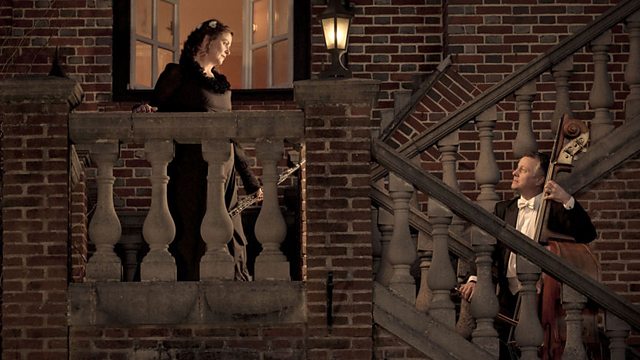
Berlioz - Romeo and Juliet
The �鶹�� NOW and Thierry Fischer perform Berlioz's Romeo and Juliet.
Penny Gore continues Radio 3's month of programmes complementing the �鶹��4 series "Symphony" with a performance of Hector Berlioz's revolutionary 'Dramatic Symphony' inspired by Shakespeare.
Berlioz: Romeo and Juliet
Susan Bickley (mezzo)
Jean-Paul Fouchecourt (tenor)
Jonathan Lemalu (baritone)
�鶹�� National Chorus of Wales
Cardiff Polyphonic Choir
�鶹�� National Orchestra of Wales
Thierry Fischer (conductor).
HECTOR BERLIOZ (1803–69)
Romeo and Juliet – dramatic symphony after Shakespeare’s tragedy (1839)
“Berlioz had been planning some kind of musical realisation of the Romeo and Juliet theme for a long time when a gift of 20,000 francs from Paganini set him to work...”
The story of Berlioz’s relationship with the Irish actress Harriet Smithson, whose Ophelia and Juliet so enchanted him in Paris in 1827 and who became his wife six years later, would not be out of place among the most extravagant examples of sentimental fiction. It was more than just a romantic episode in the composer’s life, however. The whole experience – the ‘thunderbolt’ discovery of Shakespeare by way of the Charles Kemble company’s productions (in English) at the Théâtre de l’Odéon, the passion aroused in him by the pathos of Ophelia and Juliet, his projection of their poetic aura onto the actress who so beautifully embodied them – was a significant event from every biographical and musical point of view. Next to his reverence for the Beethoven symphonies, it was one of the most profoundly formative factors in Berlioz’s artistic development.
Berlioz had been planning some kind of musical realisation of the Romeo and Juliet theme for a long time, probably since he first saw the play. But other major projects intervened, including the Symphonie fantastique (during a period of disillusionment with Harriet), its sequel Lélio (part of his resumed courtship strategy), the viola-concerto-cum-symphony Harold in Italy, the opera Benvenuto Cellini and the Requiem (Grande messe des morts). So it wasn’t until 1839 that he was able to apply himself wholeheartedly to the project. The immediate stimulus was a gift of 20,000 francs from Paganini, who had commissioned Harold in Italy in 1834 but had rejected it and only later realised what a mistake he had made when he first heard it played in Paris at the end of 1838. This subvention of conscience money set Berlioz free from other worries and, starting with ‘Romeo Alone’ (the opening of Part 2) in January 1839, he completed his ‘dramatic symphony’ less than eight months later.
Although Paganini made no stipulation as to what Berlioz should do with the 20,000 francs, he did remind his younger colleague that ‘Beethoven being dead, only Berlioz remains to make him live again’. How much that had to do with Berlioz’s decision to make his Romeo and Juliet a choral symphony broadly comparable to Beethoven’s Ninth can only be a matter for conjecture. But it does end with a large-scale choral finale and it does include three purely orchestral movements roughly equivalent, though in a different order, to the Allegro, Scherzo and Adagio of Beethoven’s Ninth. It is true that there is nothing in the Beethoven equivalent to Berlioz’s Part 1, with its combative orchestral fugue and its vocal Prologue, or the episodes set in the Capulet tomb between the Scherzo and the Finale, but Beethoven didn’t have a story to tell or a famously tragic death scene to translate into musical terms.
Programme note © Gerald Larner 2005
Duration:
Credits
| Role | Contributor |
|---|---|
| Orchestra | �鶹�� National Orchestra of Wales |
| Performer | Thierry Fischer |
| Composer | Hector Berlioz |
| Performer | Susan Bickley |
| Performer | Jean-Paul Fouchécourt |
| Performer | Cardiff Polyphonic Choir |
| Performer | �鶹�� National Chorus of Wales |
This clip is from
Featured in...
![]()
More... Symphony
More highlights from the 'Symphony' season on Radio 3 and �鶹�� Four.
More clips from Afternoon Concert
-
![]()
Charles Ives: The Unanswered Question
Duration: 06:28
-
![]()
Mahler: Adagio, from Symphony No 10 (arr. Castelletti) (excpt)
Duration: 01:43






